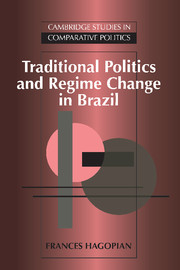Book contents
- Frontmatter
- Contents
- List of tables and figures
- Preface
- Glossary of abbreviations and Portuguese terms
- 1 Introduction: Traditional politics, new authoritarianism
- 2 Oligarchical power and traditional politics in Minas Gerais
- 3 The modern political economy of traditional politics
- 4 Bureaucratic authoritarianism and the state elite
- 5 Back to patronage: State clientelism in Minas Gerais
- 6 Authoritarian politics and traditional elites
- 7 The traditional political elite and the transition to democracy
- 8 Continuity in change: Brazilian authoritarianism and democratization in comparative perspective
- Appendix: The Minas elite
- References
- Index
8 - Continuity in change: Brazilian authoritarianism and democratization in comparative perspective
Published online by Cambridge University Press: 06 January 2010
- Frontmatter
- Contents
- List of tables and figures
- Preface
- Glossary of abbreviations and Portuguese terms
- 1 Introduction: Traditional politics, new authoritarianism
- 2 Oligarchical power and traditional politics in Minas Gerais
- 3 The modern political economy of traditional politics
- 4 Bureaucratic authoritarianism and the state elite
- 5 Back to patronage: State clientelism in Minas Gerais
- 6 Authoritarian politics and traditional elites
- 7 The traditional political elite and the transition to democracy
- 8 Continuity in change: Brazilian authoritarianism and democratization in comparative perspective
- Appendix: The Minas elite
- References
- Index
Summary
This study has been concerned primarily with explaining why the strategic state elite governing the Brazilian bureaucratic-authoritarian regime failed in its mission to recast the national political system, why traditional politics and a regional, traditional political elite survived rapid economic and social modernization and significant attempts at political restructuring, and what the consequences of the persistent dominance of this class have been for Brazil's new and future democracy. Whatever the expectations that regional political elites should have been easily able, in their own states, to survive a military project to “technocratize” the state, it was by no means assured that these elites could have withstood the regime's initial attacks on it to steer bureaucratic authoritarianism through its rocky second decade and the transition to democracy. It was even less apparent that traditional, clientelistic, and even oligarchical politics of the sort decried by Cardoso and Weffort in the opening passages of this book should have been restored after regime change.
Brazil's military governors initially proposed to rationalize the state, a project that was quite radical politically for it would have altered the historical patterns of decision making and elite participation in Brazilian politics. Backed by a new hegemonic alliance of foreign and domestic entrepreneurs and a technically competent state elite, the military attempted to centralize fiscal and political decisions beyond the reach of the regional oligarchies in the innermost circles of the federal state. It also set out to substitute technocratic rationality for clientelism in the state bureaucracies, thus depriving the regional oligarchies of their power bases in the state.
Ultimately, the military did not reformat patterns of politics ingrained in the fabric of Brazilian society for nearly a century.
- Type
- Chapter
- Information
- Traditional Politics and Regime Change in Brazil , pp. 253 - 282Publisher: Cambridge University PressPrint publication year: 1996

